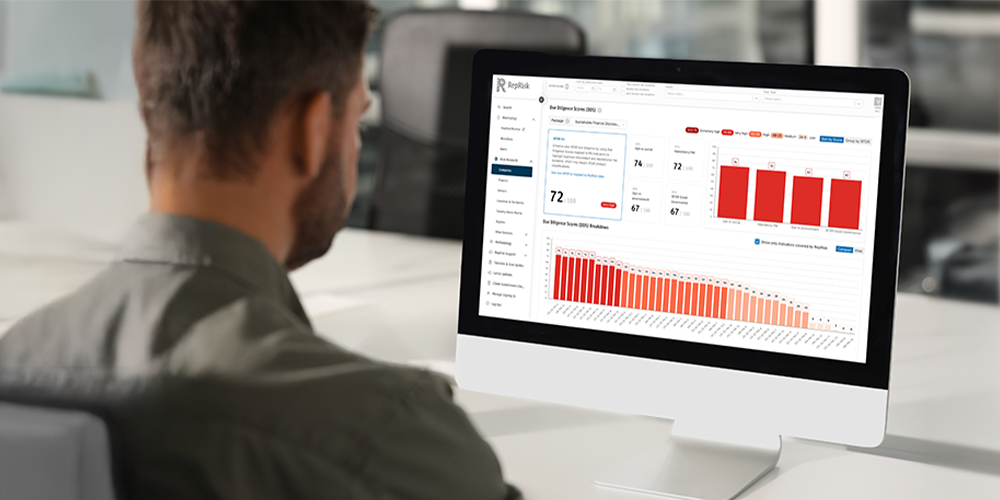January 30, 2023, Zurich, Switzerland
RepRisk endorses Code of Conduct for ESG Evaluation and Data Providers by the Japanese Financial Services Agency
RepRisk is pleased to endorse the Code of Conduct for ESG Evaluation and Data Providers (“Code”) which was established by the Technical Committee for ESG Evaluation and Data Providers of the Japanese Financial Services Agency and released in December 2022. RepRisk is proud to endorse Principles 1-4 of the Code. Principles 5 and 6 are not applicable to RepRisk’s ESG research approach (please see RepRisk’s response to the Code below for more details).
Last year, RepRisk proudly launched its subsidiary in Japan after winning Japan’s Green Finance Subsidy Program and is committed to continue contributing to the acceleration of green finance in Japan via best-in-class ESG risk data.
RepRisk echoes the call for more transparency in the ESG industry globally. In November 2021, as the first ESG data provider, it published its methodology on the website for everyone to see (RepRisk has always been transparent about its methodology with clients and partners). In November 2022, RepRisk published a Transparency Commitment Charter. The Charter ensures that investors and decision-makers can easily understand the purpose of its dataset, its methodology, the underlying data points, as well as how its metrics are constructed – and provides this information to clients and the public. This empowers users to apply the right data to their use case and to what ESG means for their organization.
# RepRisk response to the Code of Conduct for ESG Evaluation and Data Providers:
# I. Principle 1 (Securing Quality): ESG evaluation and data providers should strive to ensure the quality of ESG evaluation and data they provide. The basic procedures necessary for this purpose should be established.
RepRisk is dedicated to operational excellence and will continue delivering the highest quality in its processes, products, and services and works to improve them continuously.
Response to the Code’s guidelines:
1 and 2: The purpose of RepRisk’s dataset is to identify and assess material ESG risks. With that, it enables companies, investors, and others to proactively mitigate these risks that can lead to reputational, compliance, and financial impacts for the company and its stakeholders, as well as impacts on people and the planet. Its research procedures can be found in its public methodology. RepRisk does not publish the ESG data and metrics themselves and exclusively uses publicly available information in its research approach – hence, there is no risk of violating confidentiality or intellectual property of evaluated companies.
3. RepRisk’s methodology is fully rules-based and transparent, i.e., there is no discretion or judgment call of an analyst when it comes to evaluating the ESG risks of a company or infrastructure project; RepRisk analysts are carefully trained to follow RepRisk’s strict, rules-based methodology; and the research process includes a quality assurance check before an ESG risk incident is published to clients. More details can be found in the Transparency Commitment Charter under “Reliability.”
4 and 5: RepRisk’s methodology has been consistent since day one – when it first started its dataset in 2007 – and the way it assesses the severity, reach, and novelty of ESG risks, as well as its core research scope has not changed. This allows its clients to access a consistent time series of 18+ years of daily data that can be used for rigorous backtesting, modelling, and quantitative analysis. RepRisk’s dataset is updated daily – it screens its sources every day for ESG risk.
While the underlying methodology remains unchanged, parts of RepRisk’s research approach are dynamic and have developed to maintain quality and alignment with client feedback. Its ESG Topic Tags (which, together with ESG Issues, form RepRisk’s research scope of 108 ESG risk factors) are a dynamic concept and it expands the list in response to emerging trends. RepRisk also expands its language coverage (currently 23 languages) and list of sources regularly. Its machine learning models are also continuously refined to accurately identify ESG risk in source documents. Lastly, RepRisk expands its suite of proprietary risk metrics and solutions systematically to remain at the cutting-edge of ESG.
More details can be found in the Transparency Commitment Charter under “Sources,” “Reliability,” and “Timeliness.”
6. In the case that RepRisk outsources ESG risk incident screening, the results of this process will go through the same research and quality assurance process as the incidents that were identified by RepRisk directly.
# II. Principle 2 (Human Resources Development): ESG evaluation and data providers should secure necessary professional human resources to ensure the quality of the evaluation and data provision services they provide, and should develop their own professional skills.
RepRisk is committed to selecting the most qualified candidates, rigorous onboarding, training them in all relevant standards of RepRisk including ethical standards, and working on their professional development by creating a feedback and action loop.
RepRisk’s response to the Code’s guidelines:
1. RepRisk’s research approach outlines how it collects and analyzes information and how it maintains professional resources and technologies to ensure highest-quality ESG data. Please see sections “Research approach,” “Reliability,” and “Timeliness” in the Transparency Commitment Charter.
2. In order to ensure data quality and consistency over time, RepRisk has an extensive quality assurance process in place. RepRisk has a team of 150+ highly skilled and carefully trained analysts across our offices around the world. Together, the analysts speak 40+ languages and play a crucial role in producing “due diligence grade” (high-quality) data and refining RepRisk’s algorithms to accurately identify ESG risk. The ESG Research leadership team conducts regular reviews and updates of the underlying research manual and the analyst team leverages feedback forums and group discussions on a daily basis to ensure alignement and quality, in addition to attending regular training sessions.
3. RepRisk’s analyst team operates within a proprietary evaluation system that was established to maintain RepRisk’s high-quality data and ensure RepRisk’s rules-based methodology. During recruitment it evaluates language and analytical capabilities through various written and verbal exercises. It tracks qualitative and quantitative performance indicators on a per datapoint item level and reviews performance indicators on a weekly basis. In the exceptional case that RepRisk’s strict quality standards are not met, it develops tailored improvement plans.
4. RepRisk’s top management recognizes that securing and developing qualified human resources is an important element for continuously providing high-quality ESG data. RepRisks human resources approach focuses on hiring qualified staff, rigorous onboarding, continues training, evaluation and feedback combined with empowerment. This allows it to adapt to the needs of its global clientele and meeting its own standards of quality and operational excellence. The company provides staff with regular trainings via the RepRisk Academy, a proprietary internal training tool, and invests in certified external education such as by the UN-supported PRI Academy.
# III. Principle 3 (Ensuring Independence and Managing Conflicts of Interest): ESG evaluation and data providers should establish effective policies so that they can independently make decisions and appropriately address conflicts of interest that may arise from their organization and ownership, business, investment and funding, and compensation for their officers and employees, etc. With regard to conflicts of interest, providers should identify their own activities and situations that could undermine the independence, objectivity, and neutrality of their business, and avoid potential conflicts of interest or appropriately manage and reduce the risk of conflict of interest.
RepRisk exclusively focuses on ESG risk data and research and does not offer any other services or products such as indexes (based on ESG ratings that are informed by the needs of index clients) or credit ratings. Furthermore, RepRisk does not offer bespoke assessments, assurances, second-party opinions, proxy-voting or engagement services, or advisory. RepRisk is fully financed by the data subscription fees from our clients and partners (“purchaser-pays model”). Lastly, as our research is exclusively based on information external to a company, i.e., a company in our dataset cannot influence its score or risk profile.
RepRisk’s response to the Code’s guidelines:
1-8: RepRisk is free of any conflicts of interest. More details can be found in the Transparency Commitment Charter under “Free of any conflicts of interest.”
# IV. Principle 4 (Ensuring Transparency): ESG evaluation and data providers should recognize that ensuring transparency is an essential and prioritized issue, and publicly clarify their basic approach in providing services, such as the purpose and basic methodology of evaluations. Methodologies and processes for formulating services should be sufficiently disclosed.
Transparency is at the core of RepRisk and while it has always been transparent about its methodology with clients and partners, in November 2021, it published the methodology on its website for everyone to see. Moreover, in November 2022, RepRisk launched a Transparency Commitment Charter which further outlines the purpose of RepRisk’s data, its research approach, methodology, underlying data, list of services provided, and level of independence.
RepRisk’s response to the Code’s guidelines:
1-5: Please refer to the RepRisk Transparency Commitment Charter for details.
# V. Principle 5 (Confidentiality): ESG evaluation and data providers should establish policies and procedures to appropriately protect non-public information obtained in the course of business.
Principle 5 is not applicable to RepRisk as it does not acquire any confidential information on companies for the purpose of generating ESG evaluations and data (it uses publicly-available information only and company self-disclosures is excluded in its research approach).
# VI. Principle 6 (Communication With Companies): ESG evaluation and data providers should devise and improve the way they gather information from companies so that the process becomes efficient for both service providers and companies or necessary information can be sufficiently obtained. When important or reasonable issues related to information source are raised by companies subject to evaluation, ESG evaluation and data providers should appropriately respond to the issues.
Principle 6 is not applicable to RepRisk as its research approach is based on analyzing information from public sources and stakeholders, and intentionally excludes company self-disclosures. RepRisk does not have an engagement or communication process in place with companies and companies cannot influence their risk profile or score. However, anyone can contact RepRisk with any questions they have. It provides contact information publicly available on its website (including contact form, email address, phone number, and postal address). Its clients are also able to contact RepRisk directly from within its web-based tool, the RepRisk ESG Risk Platform, via its Client Support Team, or via their Account Manager.
About RepRisk
RepRisk is the world’s most respected Data as a Service (DaaS) company for reputational risks and responsible business conduct. Since 2007, RepRisk’s data has been trusted by the world’s leading banks, investment managers, Fortune 500 companies, sovereign wealth funds, and organizations such as the OECD and UN. Combining advanced AI with deep human expertise, and a proven methodology at the core, RepRisk’s solutions bring peace of mind, enabling clients to ‘know more, be sure, and act faster’. Our pioneering solutions help to strengthen due diligence processes across ESG topics, such as biodiversity, deforestation, human rights, and corruption, empowering clients to identify, monitor, and mitigate reputational, compliance, and financial risks. Headquartered in Zurich, and with offices in Toronto, New York, London, Berlin, Manila, and Tokyo, we stay close to clients and bring an independent lens to the industry. United by our shared belief in the power of data, our 400 people are proud to be setting the global standard for business conduct data and driving positive change through transparency.
Visit us at reprisk.com and follow us on LinkedIn.
2023年1月
金融庁「 ESG 評価・データ提供機関に対する行動規範」賛同表明
金融庁の専門分科会により作成され、2022年12月に公表されたESG評価・データ提供機関に係る行動規範 (以下、「行動規範」) に関し、RepRiskは、全面的に賛同、受け入れを表明致します。RepRiskは、行動規範の原則1~4に賛同します。また、原則5および6は、RepRiskのESG 調査方法に該当するものではありません。(下記のRepRiskの行動規範に対する回答をご参照ください)。
昨年、RepRisk は東京都よりグリーンファイナンス外国企業進出支援事業プログラムの補助金を受け、日本に子会社を設立致しました。最高クラスのESGリスクデータを提供することで、日本におけるグリーンファイナンス加速へ貢献すべく取り組んでおります。
世界中の ESG 業界に対する透明性への呼びかけにRepRisk は応えて参りました。2021年11月、ESGデータ提供機関として初めて会社ウェブサイトにその方法論を公開しました(以前よりお客様およびパートナーに方法論を公開してきました)。2022年11月、RepRiskは透明性コミットメント憲章を発表しました。この憲章は、投資家や各企業、機関における意思決定者がRepRiskのデータセット、方法論、基礎データポイントの目的および指標の構成を容易に理解する事を可能にし、その情報をお客様と一般の方々に提供します。これにより、ユーザーは適切にデータを利用し、組織におけるESGの意味を確認することが可能となります。
# ESG 評価・データ提供機関の行動規範に対する RepRisk の回答:
原則1 (品質の確保):ESG 評価・データ提供機関は、提供するESG評価・データの品質確保を図るべきである。このために必要な基本的手続き等を定めるべきである。
RepRiskは、オペレーショナルエクセレンスの実現に専念し、最高品質のプロセス、商品、サービスを提供し、これらを継続的に改善することに取り組んでいます。
行動規範の指針に対する回答:
1および2:RepRiskのデータセットの目的は、重大なESGリスクを特定・評価することです。これにより、企業、投資家、その他の組織は、風評(レピュテーション)やコンプライアンス、財務に影響を与えるリスクを積極的に軽減できるとともに、地球や地域の人々への影響を低減します。当社は調査の方法論を一般に公開しております。RepRiskでは、ESG データや指標そのものは一般に公表しておらず、また、公開情報のみを用いて調査を行うため、評価対象企業の機密情報や知的財産を侵害するリスクはありません。
3.RepRisk の方法論は非常に透明性が高く、完全にルールに基づいて行われます。企業やインフラストラクチャー・プロジェクトの ESG リスクを評価する際、アナリストが自身の判断を下したり、個人的な意見を表明することはありません。RepRiskのアナリストはRepRiskの厳格なルールに基づいた方法論に従うように入念に訓練を受けており、そのプロセスには、ユーザーへESG リスクインシデントを知らせる前にデータの品質管理チェックを行うことも含まれています。より詳しい情報は、透明性コミットメント憲章の「信頼性」項目をご参照ください。
4および5:RepRiskの方法論は、ESGリスクの深刻度、情報到達範囲、新規性の評価方法を2007年にデータセットの構築を開始した時から変更しておらず、また中核となる調査対象範囲も変わっていません。したがって、お客様は、18年以上にわたる期間の日次データを評価することができ、これらのデータはバックテスティング(過去データの検証)、モデリング、および定量分析に使用することが可能です。ESGリスクを特定するために毎日情報源がスクリーニングされ、RepRisk のデータセットは日々更新されています。
基本的な方法論は変らないものの、RepRiskの調査方法の一部は流動的に運用され、お客様のフィードバックとの整合性と品質維持のために開発を重ねています。ESGトピックタグ(ESG 関連課題とともに、108のESGリスク要因のRepRiskの調査対象範囲)は流動的な考え方であり、最新動向に応じてリストを拡張しています。また、対象言語範囲(現在23か国語)と情報源リストを定期的に拡大し続けており、当社の機械学習モデルは、原文のESGリスクを正確に特定するために、継続的に改良されています。RepRiskは独自評価指標とソリューションを体系的に拡大し ESGの最先端を維持することに努めています。
より詳しい情報は透明性コミットメント憲章内、「情報源」、「信頼性」、「適時性」の項目をご参照ください。
6.RepRiskがESGリスクインシデントのスクリーニングを外部委託する場合にも、RepRiskが直接特定したインシデントと同様の調査および品質管理プロセスを経ることになります。
原則2 (人材の育成):ESG 評価・データ提供機関は、自らが提供する評価・データ提供サービスの品質を確保するために必要な専門人材等を確保し、また、自社において、専門的能力の育成等を図るべきである。
RepRiskは、最適な候補者を選定し、厳格な入社研修を実施、倫理基準を含むRepRiskのすべての関連基準についてトレーニングを行い、フィードバックやアクションループを作成することで、専門的能力の開発に取り組んでいます。
行動規範指針へのRepRiskの回答:
1. RepRiskの調査方法は、最高品質のESGデータを確保するための、情報の収集・分析方法および専門的なリソースや技術の維持方法について概説しています。透明性コミットメント憲章の「調査方法」、「信頼性」、「適時性」をご参照ください。
2. データ品質と長期的な一貫性を確保するために、RepRiskは徹底した品質保証プロセスを活用しています。RepRiskは、世界各地の各拠点に150名以上の十分に訓練された高い技能を有するアナリストチームを擁しています。アナリストは計40か国語以上を話し、正確にESGリスクを特定するために、「デューデリジェンスグレード」(高品質)のデータ作成およびRepRiskのアルゴリズムの改良に重要な役割を果たしています。ESG調査リーダーシップチームは、基礎調査マニュアルに定期的な見直しと更新を行い、アナリストチームは定期的なトレーニングへの参加に加えて、日々のフィードバックフォーラムとグループ討議を利用することでデータの整合性と品質を確保しています。
3. アナリストチームは、RepRiskの高品質のデータを維持しルールに基づいた方法論を確保するため確立された独自の評価システムを運営しています。採用時には、様々な筆記試験や口頭試験を通して言語と分析能力を評価します。定性・定量的パフォーマンス指標をデータポイント単位で把握し、週単位でパフォーマンス指標を見直します。RepRiskの厳格な品質基準に達しない例外的なケースでは、各々に合わせた改善計画が策定されます。
4. RepRiskの経営陣は高品質のESGデータを継続的に提供するためには、有能な人材の確保と育成が重要な要素であることを認識しています。RepRiskの人材育成方法は、有能な人材の採用、厳格な入社研修、継続的なトレーニング、評価、フィードバックと権限委任の組み合わせに重点を置いています。これにより多国籍な顧客のニーズに応え、品質とオペレーショナルエクセレンスの自社基準を満たすことができます。当社は、独自の社内研修ツールであるRepRiskアカデミーを通して社員に定期的なトレーニングを提供し、国連が支援するPRIアカデミーなどの外部認証教育機関に教育投資しています。
原則3 (独立性の確保・利益相反の管理):ESG 評価・データ提供機関は、独立して意思決定を行い、自らの組織・オーナーシップ、事業、投資や資金調達、その他役職員の報酬等から生じ得る利益相反に適切に対処できるよう、実効的な方針を定めるべきである。利益相反については、自ら、業務の独立性・客観性・中立性を損なう可能性のある業務・場面を特定し、潜在的な利益相反を回避し、又はリスクを適切に管理・低減するべきである。
RepRiskは、ESGリスクデータと調査のみに重点を置き、(インデックスクライアントの要望により反映されたESG評価に基づく)インデックスまたは信用格付けなどの他のサービスや商品は一切提供していません。さらにRepRiskは、オーダーメイドの評価、保証、第三者の意見、代理投票またはエンゲージメントサービスやアドバイザリー等は提供しておりません。RepRiskは、お客様およびパートナーからのデータ利用料金のみで財源を賄っています(購入負担者モデル)。また、当社の調査は、企業外部からの情報のみに基づいており、故に、当社のデータセットに含まれる企業は、自社のスコアやリスクプロフィールに影響を及ぼすことはできません。
行動規範指針へのRepRiskの回答:
1-8 : RepRiskには利益相反はありません。より詳しい情報は、透明性コミットメント憲章の「利益相反について」項目をご参照ください。
原則4 (透明性の確保):ESG 評価・データ提供機関は、透明性の確保を本質的かつ優先的な課題と認識して、評価等の目的・基本的な方法論等、サービス提供に当たっての基本的考え方を一般に明らかにするべきである。また、サービス策定の方法論・プロセス等について、十分な開示を行うべきである。
透明性はRepRiskの核心であり、お客様やパートナーには常にその方法論を公開してきましたが、2021年11月には、誰もが確認できるよう、当社はその方法論をウェブサイトに公開しました。さらに2022年11月、RepRiskは 透明性コミットメント憲章を発表しました。これは RepRiskのデータの目的、調査方法、方法論、基礎データ、提供サービスリスト、独立性をさらに詳しく説明するものです。
行動規範指針へのRepRiskの回答:
1-5 : より詳しい情報は、RepRisk透明性コミットメント憲章をご参照ください。
原則5 (守秘義務):ESG評価・データ提供機関は、業務に際して非公開情報を取得する場合には、これを適切に保護するための方針・手続きを定めるべきである。
RepRiskはESG 評価とデータを生成する目的で企業の機密情報を取得しないため、原則5は該当しません(公開情報のみを使用し、企業の自己開示情報は調査方法から除外されています。)
原則6 (企業とのコミュニケーション):ESG評価・データ提供機関は、企業からの情報収集が評価機関・企業双方にとって効率的となり、また必要な情報が十分に得られるよう、工夫・改善すべきである。評価等の対象企業から開示される評価等の情報源に重要又は合理的な問題提起があった場合には、ESG評価・データ提供機関は、これに適切に対処すべきである。
RepRiskの調査方法は、公開情報源とステークホルダーからの情報分析に基づいており、企業の自己開示を意図的に除外するため、原則6は該当しません。RepRiskは、企業との面談などのコミュニケーションプロセスを持たず、企業は自社のリスクプロフィールやスコアに影響を与えることはできません。ただし、質問があれば、どなたでもRepRiskに問い合わせ可能です。RepRiskは、ウェブサイトに連絡先情報を公開しています(連絡フォーム、メールアドレス、電話番号、住所を含みます)。お客様は、常にクライアントサポートチームまたは担当者を通して、または RepRisk ESG Risk Platform からRepRiskに直接お問い合わせ頂けます。
RepRiskについて
RepRiskは、1998年に設立、スイスに本社を構え、森林破壊、人権侵害、汚職などのビジネス行動リスクに関する透明性を提供するグローバルなテクノロジー企業です。RepRiskは、お客様の効率的な意思決定を可能にし、組織、投資、ビジネス利益のアルファ生成と価値の維持をサポートします。RepRiskは、世界の主要銀行80行以上、大手投資運用会社25社のうち17社、また、企業や世界最大の政府系ファンドにもご利用頂いており、デューデリジェンスプロセスにおいて信頼を得ています。RepRisk は、人間によるキュレーションと最先端の人工知能を使用して、上場企業、非上場企業、実物資産、国に関する世界で最も包括的なビジネス行動および生物多様性リスクのデータセットを生成しています。
詳しくは、 www.reprisk.comをご覧ください。



